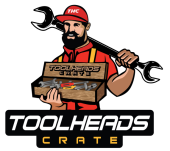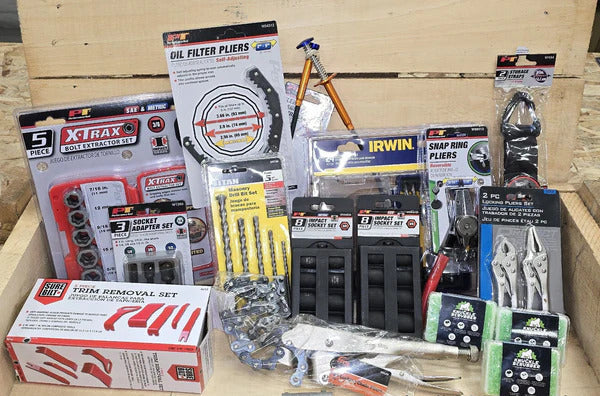Whether you’re hanging a picture, tightening a loose screw, or embarking on your first woodworking project, having the right basic hand tools at your fingertips can turn a daunting task into a simple, satisfying accomplishment. Every home deserves a well stocked hand tool box or sturdy tool crate not just for emergencies, but for everyday fixes and creative DIY projects.
If you’re new to home improvement or just starting to build your own collection, this beginner’s guide will walk you through the essential hand tools for beginners, how to organize your tool box, tips for choosing the right storage, and how to care for your investment. Let’s get you set up for DIY success!
What Are Basic Hand Tools?
Best basic hand tools for homeowners are the backbone of any DIYer’s arsenal. Unlike power tools, which require electricity or batteries, hand tools operate solely through manual effort. This makes them portable, versatile, and often safer for beginners. With no cords to trip over or batteries to charge, you can grab your tools and get to work anywhere whether it’s under the sink, in the garden, or on a camping trip.
These tools include household staples like the screwdriver, hammer, wrench, pliers, measuring tape, and utility knife. Each serves a unique purpose, from driving screws and pounding nails to measuring, gripping, and cutting materials. Their simplicity makes them easy to learn and reliable in any situation no matter your skill level. For anyone looking to build confidence in home repair or woodworking, mastering these tools is the first step in the beginner’s guide to using hand tools.
Must Have Basic Hand Tools for Every Home
A well rounded starter tool kit doesn’t need to be overwhelming or expensive. Here are the best basic hand tools for homeowners and DIY beginners, along with practical uses for each:
Screwdrivers (Flathead and Phillips)
- Flathead Screwdriver: Used for screws with a single groove across the head. Ideal for assembling furniture, opening paint cans, and tightening cabinet hardware.
- Phillips Screwdriver: Features a cross shaped tip for Phillips head screws, common in electronics, appliances, and door hinges. Having both types in multiple sizes ensures you’re ready for any screw you encounter.
Hammer (Claw Hammer)
- Claw Hammer: The classic 16oz claw hammer is perfect for driving nails into wood, hanging pictures, assembling furniture, or even light demolition. The claw end helps remove nails or pry apart boards truly a multitasker in your hand tool box.
Pliers (Needle Nose and Slip Joint)
- Needle Nose Pliers: Great for gripping small objects, bending wires, or reaching into tight spaces essential for electrical work or jewelry repairs.
- Slip Joint Pliers: Adjustable jaws make these pliers suitable for gripping, twisting, or turning a variety of objects, from plumbing fixtures to stubborn nuts and bolts.
Wrenches (Adjustable Wrench and Socket Set)
- Adjustable Wrench: The movable jaw adapts to different sizes of nuts and bolts, saving you from buying a full set. Perfect for plumbing repairs, bicycle maintenance, or assembling flat pack furniture.
- Socket Set: Offers a range of socket sizes for tightening or loosening bolts quickly and efficiently, especially useful for automotive or mechanical tasks.
Measuring Tape & Level
- Measuring Tape: A 5 meter (16 foot) tape with both metric and imperial units is a must for measuring spaces, furniture, or materials before cutting or installing.
- Level: Ensures shelves, frames, and appliances are perfectly horizontal or vertical, preventing wonky installations and future headaches.
Utility Knife
- Utility Knife: Also known as a Stanley knife, this tool is indispensable for cutting cardboard, trimming carpet, scoring drywall, or opening packages. Look for a retractable or folding blade for safety.
Hand Saw or Hacksaw
- Hand Saw: Ideal for cutting wood for small repairs, shelving, or garden projects.
- Hacksaw: Designed for cutting metal pipes, plastic, or bolts handy for plumbing or automotive fixes.
With these must have tools in a starter tool kit, you’ll be equipped to tackle most household repairs, creative projects, and unexpected emergencies.
Choosing the Right Hand Tool Box or Tool Crate
Proper storage is the unsung hero of tool ownership. The way you store your tools can impact their lifespan, your efficiency, and even your safety. When choosing between a hand tool box and a tool crate, consider your needs:
|
Feature |
Hand Tool Box |
Tool Crate |
|
Portability |
Lightweight, easy to carry |
Heavier, often stationary |
|
Capacity |
Holds essential, smaller tools |
Fits larger or more numerous tools |
|
Organization |
Multiple compartments/trays |
Open space, sometimes stackable |
|
Best For |
Homeowners, mobile DIYers |
Workshop, garage, heavy duty users |
- Hand tool boxes are perfect for beginners and homeowners who want to keep their tools organized and portable. Look for boxes with compartments, sturdy handles, and durable materials.
- Tool crates are better for those with a dedicated workspace or a growing collection, offering more space for bulkier tools and accessories.
How to Organize a Hand Tool Box
- Sort tools by function and frequency of use keep most used items on top or in accessible trays.
- Use labels or color coded sections for quick identification.
- Avoid overloading store only essentials to keep your box manageable and efficient.
- Magnet strips can hold small metal parts like screws and nails, preventing accidental injury.
Tips for Using and Maintaining Basic Hand Tools
Taking care of your tools is as important as owning them. Well maintained tools last longer, perform better, and are safer to use.
How to Care for Your Hand Tools
- Clean tools after each use: Wipe off dirt, dust, and moisture to prevent rust.
- Oil moving parts: Apply a light machine oil to hinges, joints, and blades to keep them operating smoothly.
- Sharpen blades regularly: Tools like utility knives and saws work best with sharp edges.
- Store in a dry place: Moisture is the enemy of metal tools use silica gel packs or dehumidifiers in your storage area if needed.
Tool Safety Tips
- Handle sharp tools with care: Always cut away from your body and retract blades when not in use.
- Wear gloves and eye protection: Especially when working with sharp or heavy tools.
- Use the right tool for the job: Improper use can damage tools and cause injuries.
- Inspect tools before use: Look for cracks, loose handles, or dull blades and repair or replace as needed.
Regular maintenance not only keeps your tools in top shape but also helps prevent accidents and ensures your projects go smoothly.
How to Start Building Your First Tool Set
You don’t need to buy everything at once. Here’s how to start smart:
- Begin with a starter kit: Many brands offer top rated hand tool sets for beginners that include the essentials at an affordable price3.
- Prioritize quality over quantity: Invest in durable, well made tools rather than buying large, cheap sets that may break easily.
- Buy tools as you need them: Focus on the basics first, then add specialty tools for specific projects (like woodworking or plumbing).
- Shop for affordable hand tools for home use: Look for sales, secondhand options, or reputable brands known for reliability.
Remember, the best tool collection is one that fits your needs and grows with your skills. Whether you’re a DIY enthusiast, homeowner, or aspiring woodworker, buy what you’ll actually use and enjoy the process of learning new skills.
Conclusion
A well stocked tool crate or hand tool box is the foundation of every confident DIYer’s journey. With the essential hand tools for beginners from screwdrivers and hammers to pliers, wrenches, and measuring tools you’ll be ready to tackle repairs, upgrades, and creative projects around your home. Organize your tools for easy access, maintain them for years of reliable use, and invest in quality pieces that match your needs. Start small, build your collection thoughtfully, and you’ll find that mastering basic hand tools is the key to unlocking a world of DIY possibilities. Ready to take the first step? Your next project is just a tool away!
FAQ
What are the most essential hand tools?
The most essential hand tools include a flathead and Phillips screwdriver, claw hammer, needle nose and slip joint pliers, adjustable wrench, measuring tape, utility knife, and a hand saw or hacksaw.
How do I maintain my hand tools?
Clean tools after use, oil moving parts, sharpen blades regularly, and store them in a dry, organized space. Regular maintenance prevents rust and extends tool life.
What’s the difference between a tool crate and a toolbox?
A tool crate is larger and more stationary, ideal for workshops or garages, while a toolbox is portable, compact, and perfect for homeowners or those who move their tools frequently.



